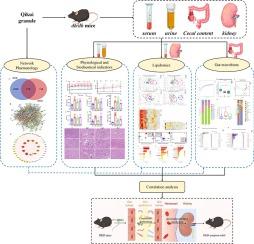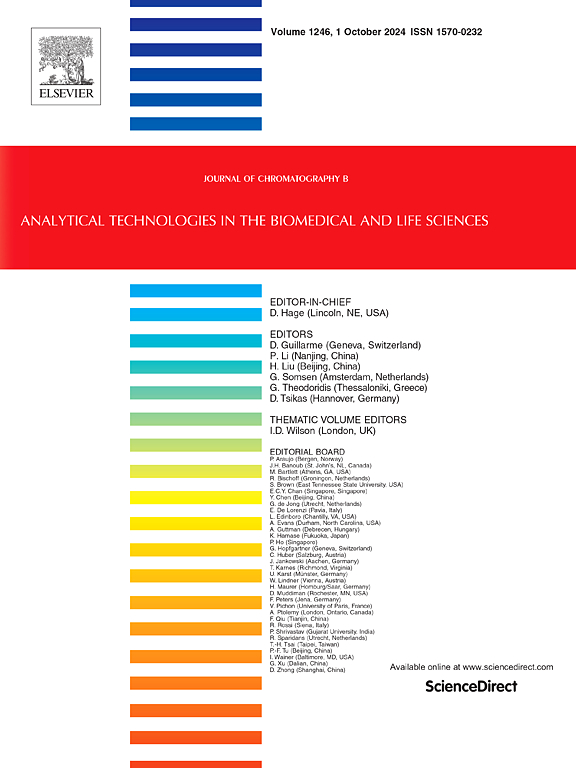Integrating lipidomics, 16S rRNA sequencing, and network pharmacology to explore the mechanism of Qikui granule in treating diabetic kidney disease mice
IF 2.8
3区 医学
Q2 BIOCHEMICAL RESEARCH METHODS
引用次数: 0
Abstract
Qikui granule (QKG), a hospital preparation of traditional Chinese medicine, has been widely used for diabetic kidney disease (DKD) in clinical practice. However, its holistic therapeutic effects and the underlying therapeutic mechanisms remain unclear. In the present study, the integrated analysis of network pharmacology, 16S rRNA sequencing, and non-targeted lipidomics was performed to explore the anti-DKD effects of QKG and the underlying mechanisms in db/db mouse DKD model. The results of the network pharmacology analysis identified the PI3K-AKT, EGFR, MAPK, JAK-STAT, FoxO, and AGE-RAGE signaling pathways as the potential molecular mechanisms responsible for the efficacy of QKG. Importantly, these signaling pathways were found to be closely related to lipid metabolism and gut microbiota. The therapeutic effectiveness of QKG against DKD was manifested by reducing body weight, alleviating oxidative stress, improving kidney function indicators, promoting the recovery of renal histopathological damage, and regulating the lipid metabolic profile of serum and kidney in db/db mice. A total of 26 lipid metabolites were identified as potential pharmacological biomarkers (PPBs) of QKG for the treatment of DKD, which were mainly involved in glycerophospholipid metabolism. Meanwhile, QKG could alleviate DKD-induced gut microbiota dysbiosis primarily by enriching Candidatus_Arthromitus, which showed a negative correlation with all 26 lipid PPBs as well as 5 biochemical parameters, including 2 oxidative stress factors and 3 kidney function indices. In conclusion, our findings suggest that QKG may upregulate the gut level of Candidatus_Arthromitus to suppress the abnormal activation of PI3K-AKT related signaling pathway, thereby reducing the levels of PC and LPC in the glycerophospholipid metabolism, to finally ameliorate the progression of DKD in db/db mice.

整合脂质组学、16S rRNA测序和网络药理学,探索芪蛭颗粒治疗糖尿病肾病小鼠的机制
芪蛭颗粒(QKG)是一种中药院内制剂,在临床上被广泛用于治疗糖尿病肾病(DKD)。然而,芪蛭颗粒的整体治疗效果和内在治疗机制尚不明确。本研究通过网络药理学、16S rRNA测序和非靶向脂质组学的综合分析,探讨了QKG在db/db小鼠DKD模型中的抗DKD作用及其内在机制。网络药理学分析结果表明,PI3K-AKT、表皮生长因子受体、MAPK、JAK-STAT、FoxO和AGE-RAGE信号通路是导致QKG疗效的潜在分子机制。重要的是,这些信号通路与脂质代谢和肠道微生物群密切相关。QKG对DKD的疗效表现在减轻体重、缓解氧化应激、改善肾功能指标、促进肾组织病理损伤的恢复以及调节db/db小鼠血清和肾脏的脂质代谢谱。共有26种脂质代谢物被鉴定为QKG治疗DKD的潜在药理生物标志物(PPBs),它们主要参与甘油磷脂代谢。同时,QKG主要通过富集血色念珠菌来缓解DKD引起的肠道微生物群失调,而血色念珠菌与所有26种脂质PPBs以及5种生化指标(包括2种氧化应激因子和3种肾功能指标)均呈负相关。总之,我们的研究结果表明,QKG可能会上调肠道中的阿血色念珠菌水平,抑制PI3K-AKT相关信号通路的异常激活,从而降低甘油磷脂代谢中PC和LPC的水平,最终改善db/db小鼠DKD的进展。
本文章由计算机程序翻译,如有差异,请以英文原文为准。
求助全文
约1分钟内获得全文
求助全文
来源期刊

Journal of Chromatography B
医学-分析化学
CiteScore
5.60
自引率
3.30%
发文量
306
审稿时长
44 days
期刊介绍:
The Journal of Chromatography B publishes papers on developments in separation science relevant to biology and biomedical research including both fundamental advances and applications. Analytical techniques which may be considered include the various facets of chromatography, electrophoresis and related methods, affinity and immunoaffinity-based methodologies, hyphenated and other multi-dimensional techniques, and microanalytical approaches. The journal also considers articles reporting developments in sample preparation, detection techniques including mass spectrometry, and data handling and analysis.
Developments related to preparative separations for the isolation and purification of components of biological systems may be published, including chromatographic and electrophoretic methods, affinity separations, field flow fractionation and other preparative approaches.
Applications to the analysis of biological systems and samples will be considered when the analytical science contains a significant element of novelty, e.g. a new approach to the separation of a compound, novel combination of analytical techniques, or significantly improved analytical performance.
 求助内容:
求助内容: 应助结果提醒方式:
应助结果提醒方式:


